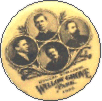|
The King of Ragtime
“Ragtime grew up in the cafes, saloons and sporting houses of the Midwest in the early 1890’s” says Joshua Rifkin on the Nonesuch Album of “Scott Joplin Piano Rags.”
Arthur Pryor and Scott Joplin both grew up in the Missouri/Mississippi River area. Joplin was two years older. Both were familiar with the earliest sounds of ragtime. Each had a tremendous effect on spreading the music throughout America and Europe. Joplin’s first major composition was Maple Leaf Rag (1899). Pryor’s first famous rag was Razazza Mazzazza, called the "king of rags" in the 1906 Victor Record catalogue. As a famous trombone soloist, Pryor was best-known as a trombone recording artist and performer with Sousa’s band. His “ragtime” compositions were a sideline. An interesting comparison follows, but first a profile of Scott Joplin:
Scott Joplin (1868-1917)
Joplin, with his formal classical training and ability to notate (write down) the ragtime rhythms, was able to refine the style and have his compositions published. His “Maple Leaf Rag” was written in 1899, the “Entertainer (Rag)” in 1902.
He lived in St. Louis in 1885 - 1893 and in Sedalia, Missouri in 1894. He played second cornet in the Queen City Concert Band and attended George Smith (Methodist) College. He began entertaining at the piano at age 13 and played during college at the Maple Leaf Club. Joseph Stark, a Sedalia music dealer and publisher was the first to publish one of Joplin’s compositions (Maple Leaf Rag) in 1906 . In 1907 Joplin moved to Chicago and later to New York where he performed and made piano rolls.
“Although ragtime was essentially a piano music, instrumentations of the rags were much in evidence for dancing to, singing to, marching to, listening to. Fifteen Standard High Class Rags, known by its New Orleans nickname “The Red Back Book” comprised a selection of John Stark’s (publisher) most successful rags, arranged for a combination of eleven instruments, equally suitable for dance floor, theater pit, or park bandstand.”
( “Scott Joplin The Red Back Book “ - Vera Brodsky Lawrence - 1985 Angel Records)
His works include: 33 well-known compositions and 2 operas (1 unpublished)
The comparison between Pryor and Joplin continues:
- Joplin toured as a performer (piano) of his works and made recordings (piano rolls) of his ragtime compositions.
- Pryor toured as a performer (trombone), primarily of his technical solos for trombone. His own touring concert band performed his ragtime compositions by Sousa’s band, and eventually.
- Joplin’s rags were among those orchestrated for small band in the “Red Back Book”.
- Pryor’s rags were readily available through several publishers.
- Joplin wrote about 15 rags, which became well-known compositions (also 2 operas -1 unpublished)
- Pryor wrote about 15 selections, ragtime in nature, as a part of his almost 80 compositions.
- Joplin’s rags, made especially popular through its use in the movie “The Sting” today are readily available in sheet music and recordings.
- Pryor’s rags are rarely played, almost all are out of print..
- Most music lovers can recognize 2-3 of Joplin’s rags, while none of Pryor’s is well-known.
- Joplin cut six piano rolls in 1916 – 1917, just two years prior to his death. These were later transferred to a few 78’s and LPs. There was not a large distribution of his performances, however, his piano music was bought and performed by many.
- Pryor made many recordings of his ragtime compositions, performed primarily by his own band.
- Joplin died at age 49, having made only 5 recordings (piano rolls) of his performances. Although known by many, he had been seen live by a relatively few number of people.
- Pryor died at age 79, having made hundreds of recordings or live performances in Europe or America.
- The titles of Joplin’s rags are generally named for places or things. These titles are much more acceptable in today’s society.
- The titles of Pryor’s works often use stereotyped names for black figures dancing or enjoying the music. While no disrespect was probably intended by these titles, they are frowned upon in today’s societies – giving even more justification for the works being rarely performed.
- Joplin was known as the “King of Ragtime”.
- Pryor’s Razazza Mazzazza was called the "king of rags" and in 1919 it was his band who introduced the popular Swanee by George Gershwin in a concert in New York City.
- Joplin and his music were largely forgotten until several of his rags were selected for the soundtrack of the popular movie, The Sting (1973), and this in turn led to a revival of interest in more of his music.
- Pryor is best known as a performer and composer/arranger of trombone solos. His famous popular composition was “The Whistler and His Dog” , not a rag, written in 1905.
The Heritage encyclopedia of Band Music lists Pryor’s output as 78 compositions:
30 marches
10 trombone solos
6 waltzes
6 two-steps
26 other works > at least 15 of these could qualify as ragtime compositions
Back to Arthur Pryor
Return to Performers
|

